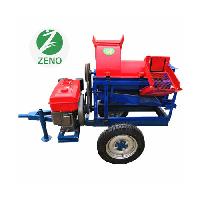Managing Irrigation and Water Needs on Your Farm

Posted by zenosheller
from the Agriculture category at
31 Oct 2024 02:27:20 am.
Implementing the following practices can increase the efficient use of irrigation on your farm or growing system. The higher the efficiency, the fewer nutrients lost and better environmental and economic outcomes. But before that, you need to learn and understand the specific irrigation practices for better farming outcomes.
Assessing Water Needs
Assessing crop water needs is a crucial component of irrigation pump management, ensuring that crops receive the right amount of water for optimal growth and yield without overuse or waste. It's important to develop an understanding of your crop's water needs so it can develop and grow into a healthy crop.
Understanding Factors Influencing Crop Water Requirements
Understand the Water Requirements of your Crop: Determine the specific water needs for each crop based on their species, growth stage, and your local climate conditions.
Understand your Soil: Consider other environmental factors like soil type, clay, root depth, and canopy cover when assessing water requirements.
Clay: less than 0.002mm
Silt: 0.002-0.05mm
Sand: 0.05-2mm
Stones: bigger than 2mm in size
Chalky soils also contain calcium carbonate or lime
Understand and Calculate Evapotranspiration Rates (ET):
Many factors go into ET such as; solar radiation intensity, air temperature, wind speed, humidity, vegetative leaf area of the plant, and the stage of the plant roots. These are called your potential evapotranspiration (PET) or ET₀.
You can use these factors to estimate water loss through evaporation and plant transpiration. It's understandable that during drought conditions plants may not be able to extract water fast enough to keep up with evapotranspiration and you will have to compensate.
These variables change seasonally in the United States but may change hourly or even minute-to-minute. You may need to adjust irrigation schedules based on weather conditions and ET data. Take a look at your local weather station to help you find your PET / ET₀.
You can also find climate data in Farmbrite. It offers weather insights in-app as well as national weather and climate data in charts and graphs. This gives you historical data at your fingertips but you can also create climate gauges to keep track of specific areas on your farm. You can track weather, temperature, humidity, or anything that is of interest to growing better crops.
Calculating Evapotranspiration Rates
Calculating ET can be a bit complicated because you will be considering soil-water balance, aerodynamic and surface resistance as well as other factors. There are many variables and coefficients in these equations but we will try to make it a little more easy to understand.
There are several methods to calculate your evapotranspiration. Each has variables that they take into account. Some are better for more arid areas and some have taken out some variables to be easier to calculate. Below you will find information on the different methods but here are calculators to help you with these sometimes complicated equations.
Here is an Evapotranspiration Calculator created by the Food and Agriculture Organization of the United Nations. This is a desktop version that can be downloaded on your computer.
Here is an Evapotranspiration Calculator created by the EPA. It has both a BETA version and a desktop version. It was created with watershed modeling and climate change assessments in mind.
Here is a calculator that was created in collaboration with several Canadian Universities and the Canadian government. It outlines the formulas and the various methods.
Evapotranspiration Methods:
As we've discussed there are many methods to calculate ET. They each have their benefits and considerations. Please do more research on which method might be the best for your area and your crops and double-check your calculations.
The Penman-Monteith Method (PM):
The PM method is a widely used calculation and is a highly regarded and used approach for estimating evapotranspiration (ET), specifically reference evapotranspiration (ET₀). It is considered one of the most accurate methods for estimating ET because it incorporates various climatic factors, including temperature, humidity, wind speed, and solar radiation.
The Penman-Monteith method is often recommended by the Food and Agriculture Organization (FAO) and other agricultural and environmental organizations for its robustness and accuracy.
Tags: irrigation
0 Comments



